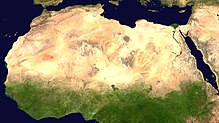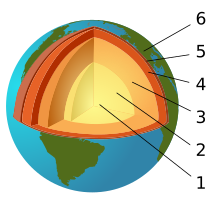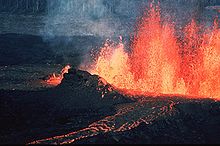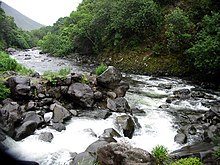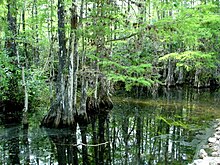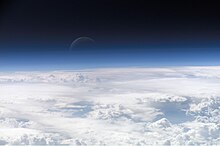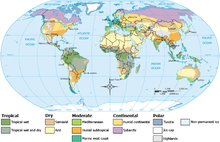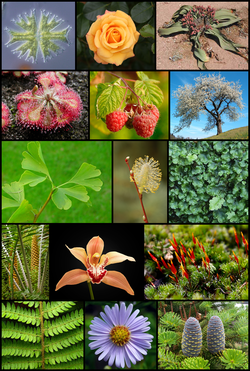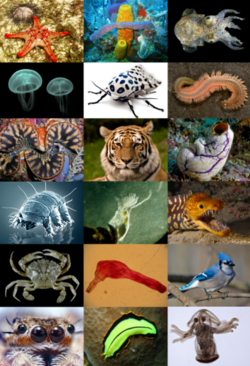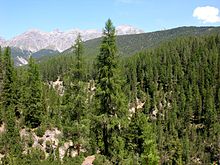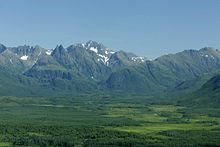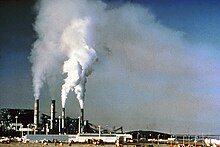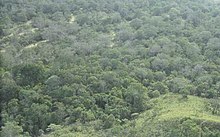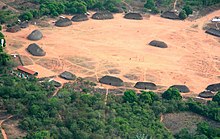Natural environment
The natural environment (also written environment) or natural environment is the set of external physical, chemical and biological components with which that living things interact. The environment encompasses the interaction of all living species, the climate, and natural resources that affect human survival and economic activity. The following can be distinguished as components of the environment:
- Complete ecological units that operate as natural systems, including all vegetation, microorganisms, soil, rocks, atmosphere and natural phenomena that occur within their limits and nature.
- Universal natural resources and physical phenomena that lack defined limits, such as air, water and climate, as well as energy, radiation, electrical load and magnetism, do not originate in civilized human actions.
In contrast to the natural environment is the built environment. In areas where man has fundamentally transformed landscapes such as urban environments and agricultural land conversion, the natural environment is greatly modified in a simplified human environment. Even acts that seem less extreme, like building a mud hut or a photovoltaic system in the desert, the modified environment becomes an artificial one. Although many animals build things to provide a better environment for themselves, they are not humans, therefore beaver dams, and the works of termites, termite mounds, or mounds, are considered natural.
People rarely find absolutely natural environments on Earth, and naturalness generally varies on a continuum, from 100% natural at one extreme to 0% natural at the other. More precisely, we can consider the different aspects or components of an environment, and see that its degree of naturalness is not uniform. If, for example, in an agricultural field, the mineralogical composition and structure of its soil are similar to those of an undisturbed forest floor, but the structure is quite different.
The term environment is often used synonymously with habitat, for example, when it is said that the natural environment of giraffes is the savannah.
According to the United Nations Environment Program (UNEP) it is most commonly used in reference to the "natural" environment, or the sum of all living and abiotic components that surround an organism, or group of organisms. The natural environment includes physical components such as air, temperature, relief, soil and bodies of water as well as living components: plants, animals and microorganisms. There is also the "built environment", which comprises all the elements and processes made by man. In macroscopic terms, the environment is usually considered as a sector, a region or a whole (global scale). At each of these levels or scopes of study there is an interaction between air, water or soil as abiotic agents and a wide variety of animal and plant organisms, with different levels of cellular organization, as members of the biotic world.
Composition
Earth sciences generally recognize the following four spheres as components of the systems that make up the totality of the natural environment:
- the litosphere
- the hydroosphere
- the atmosphere
- biosphere
These spheres correspond to the set of rocks, water, atmosphere and life, respectively.
Some scientists include, as part of the spheres of the Earth, the cryosphere (corresponding to ice) as a distinct portion of the hydrosphere, as well as the pedosphere (corresponding to the soil) as an active and intermingled sphere of the previous four.
Earth sciences (also known as geosciences or geological sciences) encompasses all sciences related to the direct study of planet Earth itself. There are different disciplines in earth sciences, such as physical geography, geology, paleontology, geophysics, climatology, oceanography or geodesy, among others. These disciplines use physics, chemistry, biology, geochronology, and mathematics to develop a qualitative and quantitative understanding of the major areas or spheres of the Earth.
Geological activity
The earth's crust, or lithosphere, is the outermost solid surface of the planet and is chemically and mechanically different from the underlying mantle. It is the layer of rock on Earth with which life and humans interact. It has been generated largely by igneous processes in which magma cools and solidifies to form solid rock. Beneath the lithosphere is the mantle that is heated by the decay of radioactive elements. The mantle, although solid, is in a state of rheological convection. This convection process causes the lithospheric plates to move, albeit slowly. The resulting process is known as plate tectonics. Volcanoes result primarily from the melting of material from the subducted crust or rising mantle at mid-ocean ridges and mantle plumes.
Water on Earth
Most of the water is found in one or another type of natural body of water.
Oceans
An ocean is a major body of saline water and a component of the hydrosphere. Approximately 71% of the Earth's surface (an area of about 362 million square kilometers) is covered by the ocean, a continuous body of water that is typically divided into several major oceans and smaller seas. More than half of this area is more than 3,000 meters (9,800 feet) deep. Average ocean salinity is around 35 ppt (parts per thousand) (3.5%), with almost all seawater having a salinity in the 30 to 38 ppt range. Although generally recognized as several "separate" oceans, these waters comprise a global, interconnected body of saltwater often known as the world ocean or global ocean. The deep seabed is more than half of the Earth's surface, and are among the least modified natural environments. The major oceanic divisions are defined in part by continents, various archipelagos, and other criteria: these divisions are (in descending order of size) the Pacific Ocean, the Atlantic Ocean, the Indian Ocean, the Southern Ocean, and the Arctic Ocean.
Rivers
A river is a natural watercourse, usually freshwater, that flows into an ocean, lake, sea, or other river. A few rivers simply flow into the ground and dry up completely before reaching another body of water.
The water in a river is generally in a channel, formed by a stream bed between the banks. In larger rivers there is also a broader floodplain formed by waters covering the channel. Floodplains can be very wide relative to the size of the river channel. Rivers are part of the hydrological cycle. Water within a river is generally collected from precipitation through surface runoff, groundwater recharge, springs, and the release of water stored in glaciers and snow packs.
Small rivers may also be called by other names, such as stream. Its stream is confined within a channel and a bank. Streams play an important corridor role in connecting fragmented habitats and thus in conserving biodiversity. The study of streams and watercourses is generally known as surface hydrology.
Lakes
A lake (from Latin lacus) is a land feature, a body of water that lies at the bottom of a basin. A body of water is considered a lake when it is inland, not part of an ocean, and larger and deeper than a pond.
Earth's natural lakes are generally found in montaneous areas, rift zones, and areas with recent or ongoing glaciation. Other lakes are found in endorheic basins or along the courses of mature rivers. In some parts of the world, there are many lakes due to chaotic drainage patterns left over from the last Ice Age. All lakes are temporary on geologic time scales, as they will slowly fill with sediment or spill out of their containing basin.
Ponds
A pond is a standing body of water, either natural or man-made, that is generally smaller than a lake. A wide variety of man-made bodies of water are classified as ponds, including water gardens designed for aesthetic ornamentation, fish ponds designed for commercial fish farming, and solar ponds designed to store thermal energy. Ponds and lakes are distinguished from streams by their current velocity. While currents in streams are easily observable, ponds and lakes have thermal microcurrents and wind-moderated currents. These features distinguish a pond from many other aquatic terrain features, such as creek pools and tidal pools.
Human impact on water
Humans impact water in different ways, such as river modification (through dams and stream channeling), urbanization, and deforestation. These affect lake levels, groundwater conditions, water pollution, thermal pollution, and marine pollution. Humans modify rivers using direct manipulation of channels. They are building dams and reservoirs and manipulating the direction of rivers and the path of water. Dams are good for humans: some communities need the reservoirs to survive. However, reservoirs and dams can negatively affect the environment and wildlife. Dams stop the migration of fish and the movement of organisms downstream. Urbanization affects the environment due to deforestation and changes in lake levels, groundwater conditions, etc. Deforestation and urbanization go hand in hand. Deforestation can cause flooding, decreased stream flow, and changes in riparian vegetation. Vegetation change occurs because when trees are unable to get adequate water, they begin to deteriorate, leading to a decreased food supply for wildlife in an area.
Atmosphere and climate
Earth's atmosphere serves as a key factor in sustaining the planetary ecosystem. The thin layer of gases that envelops Earth is held in place by the planet's gravity. Dry air consists of 78% nitrogen, 21% oxygen, 1% argon and other inert gases such as carbon dioxide. The remaining gases are often called trace gases, among which are greenhouse gases such as water vapor, carbon dioxide, methane, nitrous oxide, and ozone. Filtered air includes trace amounts of many other chemical compounds. Air also contains a variable amount of water vapor and suspensions of water droplets and ice crystals seen as clouds. Many naturally occurring substances can be present in small amounts in an unfiltered air sample, including dust, pollen and spores, sea spray, volcanic ash, and meteoroids. Various industrial pollutants may also be present, such as chlorine (primary or in compounds), fluorine, mercury and sulfur compounds such as sulfur dioxide (SO2).
The ozone layer of Earth's atmosphere plays an important role in depleting the amount of ultraviolet (UV) radiation that reaches the surface. Since DNA is easily damaged by UV light, this serves to protect life on the surface. The atmosphere also retains heat at night, reducing daily temperature extremes.
Layers of the atmosphere
Main Layers
Earth's atmosphere can be divided into five main layers. These layers are mainly determined by whether the temperature increases or decreases with altitude. From largest to smallest, these layers are:
- Exosphere: the outermost layer of the Earth's atmosphere extends from the exobase to the top, mainly composed of hydrogen and helium.
- Thermoosphere: the upper part of the thermoosphere is the lower part of the exosphere, called exobase. Its height varies with solar activity and varies between 350-800 km (220-500 mi; 1 150 000-2 620 000 feet). The International Space Station orbits this layer, between 320 and 380 km (200 and 240 mi).
- Mesosfera: Mesosfera extends from stratopause to 80-85 km (50-53 mi; 262 000-279 000 feet). It is the layer where most meteors burn when entering the atmosphere.
- stratosphere: the stratosphere extends from the tropopausa to approximately 51 km (32 mi; 167 000 feet). Portrapausa, which is the limit between the stratosphere and the mesosfera, is usually 50 to 55 km (31 to 34 mi; 164 000 to 80 000 feet).
- Troposfera: the troposphere begins on the surface and extends up to 7 kilometers (22 965,9 feet) at the poles and 17 kilometers (55 774,3 feet) in the equator, with some variation due to the weather. The troposphere is heated mainly by the transfer of energy from the surface, so on average the lower part of the troposphere is warmer and the temperature decreases with the altitude. Tropopausa is the limit between the troposphere and the stratosphere.
- Other layers
Within the five main layers determined by temperature are several layers determined by other properties.
- The ozone layer is contained within the stratosphere. It is located mainly at the bottom of the stratosphere of approximately 15-35 km (9.3-21.7 mi; 49 000-115 000 feet), although the thickness varies seasonally and geographically. About 90% of ozone in our atmosphere is contained in the stratosphere.
- The ionosphere, the part of the atmosphere that is ionized by solar radiation, extends from 50 to 1000 km (31 to 621 mi; 160 000 to 3 280 000 feet) and usually overlap both the exosphere and the thermoosphere. Shape the inner edge of the magnetosphere.
- The homosfera and heterosfera: The homosfera includes the troposphere, the stratosphere and the mesosfera. The top of the heterosfera is composed almost completely of hydrogen, the lightest element.
- The planetary boundary layer is the part of the troposphere that is closer to the Earth's surface and is directly affected by it, mainly through turbulent diffusion.
Effects of global warming
The dangers of global warming are increasingly being studied by a broad global consortium of scientists. These scientists are increasingly concerned about the possible long-term effects of global warming on our natural environment and on the planet. Of particular concern are climate change and global warming caused by man-made or anthropogenic emissions of greenhouse gases, primarily carbon dioxide, which can act interactively and have adverse effects on the planet, its natural environment, and the existence of human beings. It is clear that the planet is heating up, and it is heating up fast. This is due to the greenhouse effect, caused by greenhouse gases, which trap heat within the Earth's atmosphere due to their more complex molecular structure which allows them to vibrate and, in turn, trap heat and release it towards the Earth. Earth. This warming is also responsible for the extinction of natural habitats, which in turn leads to a reduction in the population of wildlife. The most recent report from the Intergovernmental Panel on Climate Change (the group of the world's leading climate scientists) concluded that the earth will warm between 2.7 and almost 11 degrees Fahrenheit (1.5 to 6 °C) between 1990 and 2100. Efforts have increasingly focused on mitigating the greenhouse gases that are causing climate change, on developing adaptive strategies to global warming, to help humans, other animal, plant, ecosystems, regions and nations to adapt to the effects of global warming. Some examples of recent collaboration to address climate change and global warming include:
- The Treaty of the United Nations Framework Convention and the Convention on Climate Change, to stabilize greenhouse gas concentrations in the atmosphere at a level that prevents dangerous anthropogenic interference in the climate system.
- The Kyoto Protocol, which is the protocol to the International Framework Convention on Climate Change treaty, again aimed at reducing greenhouse gases in an effort to prevent anthropogenic climate change.
- The Western Climate Initiative, to identify, evaluate and implement collective and cooperative forms to reduce greenhouse gases in the region, focusing on a market-based maximum-limit trading system.
A significantly profound challenge is identifying natural environmental dynamics in contrast to environmental changes that are not within natural variations. A common solution is to adapt a static view that leaves out natural variations. Methodologically, this view could be defended when slowly changing processes and short time series are observed, while the problem arises when fast processes become essential in the object of study.
Climate
Weather analyzes the statistics of temperature, humidity, air pressure, wind, rainfall, air particle counts, and other weather elements in a given region over long periods of time. Weather, on the other hand, is the current condition of these same elements for periods of up to two weeks.
Climates can be classified according to the average and typical ranges of different variables, usually temperature and precipitation. The most widely used classification scheme is the one originally developed by Wladimir Köppen. The Thornthwaite system, in use since 1948, uses evapotranspiration as well as information on temperature and precipitation to study the diversity of animal species and the possible impacts of climate change.
Weather
Weather is a collection of all events that occur in a given atmospheric area at a given time. Most weather events occur in the troposphere, just below the stratosphere. Weather generally refers to daily temperature and precipitation activity, while climate is the term for average atmospheric conditions over longer periods of time. When used without qualification, it is meant by "climate" Earth's climate.
Climate occurs due to differences in density (temperature and humidity) between one place and another. These differences can occur due to the angle of the sun at any particular location, which varies by latitude from the tropics. The sharp temperature contrast between polar and tropical air gives rise to the jet stream. Weather systems in the mid-latitudes, such as extratropical cyclones, are caused by the instability of the jet flow. Because the Earth's axis is tilted relative to its orbital plane, sunlight hits it at different angles at different times of the year. On the land surface, temperatures typically range from ±40 °C (100 °F to −40 °F) annually. Over thousands of years, changes in Earth's orbit have affected the amount and distribution of solar energy received by Earth and influence the long-term climate.
Temperature differences at the surface in turn cause pressure differences. Higher altitudes are cooler than lower ones due to differences in compression heating. Weather forecasting is the application of science and technology to predict the state of the atmosphere for a future time and location. The atmosphere is a chaotic system, and small changes in one part of the system can grow to have large effects on the system as a whole. Human attempts to control the climate have occurred throughout human history, and there is evidence that civilized human activity, such as agriculture and industry, has inadvertently modified weather patterns.
Life
Evidence suggests that life on Earth has existed for about 3.7 billion years. All known life forms share fundamental molecular mechanisms, and based on these observations, origin-of-life theories attempt to find a mechanism that explains the formation of a primordial organism of a single cell, from which all life originates. There are many different hypotheses regarding the route that might have been taken from simple organic molecules through precellular life to protocells and metabolism.
Although there is no universally agreed definition of life, scientists generally accept that the biological manifestation of life is characterized by organization, metabolism, growth, adaptation, response to stimuli, and reproduction. It can also be said that life is simply the characteristic state of organisms. In biology, the science of living organisms, "life" is the condition that distinguishes active organisms from inorganic matter, including capacity for growth, functional activity, and continuous change that precedes death.
A diverse variety of living organisms (life forms) can be found in the biosphere on Earth, and the properties common to these organisms (plants, animals, fungi, protists, archaea, and bacteria) are a cellular form based on carbon and water, with complex organization and hereditary genetic information. Living organisms have metabolism, maintain homeostasis, have the ability to grow, respond to stimuli, reproduce, and through natural selection, adapt to their environment in successive generations. The most complex living organisms can communicate through various means.
Ecosystems
An ecosystem (sometimes used to mean environment) is a natural unit consisting of all the plants, animals, and microorganisms (biotic factors) in an area that function together with all physical (abiotic) factors.) not living from the environment.
Fundamental to the ecosystem concept is the idea that living organisms are continually engaged in a set of highly interrelated relationships with all the other elements that make up the biophysical environment in which they exist. Eugene Odum, one of the founders of the science of ecology, stated:
Any unit that includes all organisms (i.e., the "community") in a given area that interact with the physical environment so that a flow of energy clearly leads to the defined trophic structure, biotic diversity and the material cycles (i.e., the exchange of materials between living and non-living parts) within the system is an ecosystem.
The concept of human ecosystem is then based on the deconstruction of the human/nature dichotomy, and the emerging premise that all species are ecologically integrated with each other, as well as with the abiotic constituents of their biotope.
A greater number or variety of species or biodiversity in an ecosystem can contribute to a greater resilience of the ecosystem, because there are more species present in a place to respond to change and therefore "absorb" or reduce their efects. This reduces the effect before the ecosystem structure is fundamentally changed to a different state. This is not universally the case and there is no proven relationship between the diversity of species in an ecosystem and its ability to provide goods and services at a sustainable level.
The term ecosystem can also refer to human-made environments, such as human ecosystems and human-influenced ecosystems, and can describe any situation where there is a relationship between living organisms and their environment. Today, there are fewer areas on the earth's surface free from human contact, although some natural or wilderness areas continue to exist without any form of human intervention.
Biomes
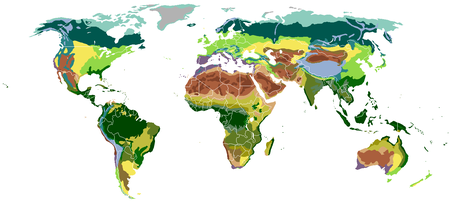
| Ice cream and polar desert Tundra Taiga Deciduous temperate forest Tempered step Subtropical forest | Mediterranean vegetation Monsonic Forest Arid desert Xerophic Dry step Semi-arid desert | Herbaceous savannah Tree savanna Subtropical dry forest Tropical forest Tundra alpine Mountain forest |
Biomes are terminologically similar to the concept of ecosystems, and are climatically defined areas of ecologically similar climatic conditions on Earth, such as communities of plants, animals, and soil organisms, often referred to as as ecosystems. Biomes are defined based on factors such as plant structures (such as trees, shrubs, and grasses), leaf types (such as leaf width and its different parts), plant spacing (in forests, savannahs, etc.)) and the weather. Unlike ecozones, biomes are not defined by genetic, taxonomic, or historical similarities. Biomes are often identified with particular patterns of ecological succession and culminating vegetation.
Biogeochemical cycles
Global biogeochemical cycles are critical to life, especially those of water, oxygen, carbon, nitrogen, and phosphorous.
- The nitrogen cycle is the transformation of nitrogen and compounds that contain nitrogen in nature. It is a cycle that includes gaseous components.
- The water cycle is the continuous movement of water on, above and below the Earth's surface. Water can change the state between liquid, steam and ice in several places of the water cycle. Although the balance of water on Earth remains quite constant over time, individual water molecules can go and come.
- The carbon cycle is the biogeochemical cycle by which carbon is exchanged between the biosphere, pedofer, geosphere, hydroosphere and Earth atmosphere.
- The cycle of oxygen is the movement of oxygen within and between its three main reservoirs: the atmosphere, the biosphere and the lithosphere. The main determining factor of the oxygen cycle is photoynthesis, responsible for the atmospheric composition and life of the modern Earth.
- The phosphorus cycle is the movement of the phosphorus through the lithosphere, the hydroosphere and the biosphere. The atmosphere does not play an important role in phosphorus movements, because phosphorus compounds are generally solid in the typical temperature and pressure ranges found on Earth.
Wild nature
Wilderness is generally defined as a natural environment on Earth that has not been significantly modified by human activity. The WILD Foundation goes into more detail, defining wildlife as:
The most intact and undisturbed wildlife areas left on our planet: those last truly wild places that humans do not control and have not developed with roads, pipelines or other industrial infrastructure.
Wilderness areas and protected parks are considered important for the survival of certain species, ecological studies, conservation, solitude, and recreation. The desert is deeply valued for cultural, spiritual, moral, and aesthetic reasons. Some nature writers believe that wilderness areas are vital to the human spirit and creativity.
The word "savage" derives from the notion of savagery; in other words, what is not controllable by humans. The etymology of the word wild comes from the Old English wildeornes, which in turn is derived from wildeor, meaning wild 'beast' (wild = 'savage' + deor = 'beast, deer'). From this point of view, it is the wildness of a place that makes it a desert. The mere presence or activity of people does not disqualify an area from being "desert." Many ecosystems that are, or have been, inhabited or influenced by human activities can still be considered "wild." This way of looking at the desert includes areas within which natural processes operate without much noticeable human interference.
Wildlife includes all plants, animals, and other non-domesticated organisms. The domestication of wild plant and animal species for human benefit has occurred many times across the planet and has a huge impact on the environment, both positive and negative. Wildlife can be found in all ecosystems. Deserts, rainforests, plains, and other areas, including the most developed urban sites, have distinct forms of wildlife. While the term in popular culture usually refers to animals that are unaffected by civilized human factors, most scientists agree that wildlife around the world is (now) affected by human activities.
Challenges
It is the common understanding of the "natural environment" that underlies environmentalism: a broad political, social and philosophical movement that advocates various actions and policies in order to protect what nature remains in the natural environment, or restore or expand the role of nature in this environment. While true wilderness is becoming rarer, "wild" nature (eg, unmanaged forests, uncultivated grasslands, wildlife, wildflowers) can be found in many previously inhabited places by humans.
Goals for the benefit of people and natural systems commonly expressed by environmental scientists and environmentalists include:
- Eliminating pollution and toxics in air, water, soil, buildings, manufactured products and food.
- Preservation of biodiversity and protection of endangered species.
- Conservation and sustainable use of resources such as water, land, air, energy, raw materials and natural resources.
- Stop global warming induced by men, which represents pollution, a threat to biodiversity and a threat to human populations.
- Change of fossil fuels to renewable energy in electricity, heating and cooling, and transportation, which addresses pollution, global warming and sustainability. This may include public transport and distributed generation, which have benefits for traffic congestion and electrical reliability.
- Change of intensive diets in meat to diets largely based on plants to help mitigate biodiversity loss and climate change.
- Establishment of natural reserves for recreational purposes and preservation of ecosystems.
- Sustainable and cleaner waste management, including waste reduction (or even zero waste), reuse, recycling, composting, converting waste into energy and anaerobic digestion of depuration muds.
- Ratification and stabilization of human population growth.
Criticism
In some cultures, the term environment is meaningless because there is no separation between people and what they see as the natural world or their environment. Specifically in the United States, many Native cultures do not recognize "environment", or see themselves as environmentalists.
Environment and indigenous peoples
Indigenous peoples are local communities that inhabit 22% of the planetary territory and have a population of between 350 and 500 million people around the world. These populations were historically established in various territories throughout the planet, in which they were adapting and creating a close relationship between the individual and the inhabited ecosystem. In this adaptation process, the indigenous peoples were modifying and creating a whole symbolic world between the environment and people, to the point of becoming or recognizing themselves as part of the natural ecosystem they inhabit; Said affirmation is supported by oral stories transmitted through the generations, which later derived and contributed to the development of their identity processes; that is why there are indigenous communities that recognize themselves as descendants of beings, animals and any other element of nature.
Currently, the overpopulation and the increase in the demands on natural resources have pushed the large companies that extract raw materials to search, negotiate and exploit new territories in search of fertile and suitable lands to continue generating resources for the large industries worldwide. This situation has resulted in the confrontation of the ways of understanding and seeing the world on the part of Western peoples and indigenous and local peoples, which has generated asymmetric interethnic relations with long-term repercussions for the groups involved.
Given the relationship between indigenous peoples and the environment, these human groups are recognized as the guardians of natural ecosystems, since they consider it part of their culture and the proper home for continuity of their cultural practices and customs. That is why any attack on the natural system and indigenous territories directly threatens life and the continuity of indigenous ways of life.
Climate change and indigenous peoples
Indigenous peoples, as a result of their close ties to their territories, are being impacted and affected by the changes that are taking place in the climate and the increase in temperatures worldwide, either through periods of rain above the usual and the worsening of the drought in arid zones. The appearance of new viruses and the extinction of local fauna species. A situation that directly threatens their economic systems and generates an exodus and mobilization of indigenous groups towards urban areas. An example known worldwide is the deforestation of the jungle Amazon from the different countries that make it up, in which case the negative impact on the soils and the introduction into the jungle of external elements that are decimating the endemic species and the indigenous communities that live in that area are evident.
Climate change is manifested in increasingly strong natural phenomena that greatly threaten the lives of human beings, likewise many times the soils and natural defenses are increasingly reduced by the force of the impact, either unprotected soils due to the felling of forests, increased temperatures due to the absence of trees, extinction of species, and limitation of crops due to flooding, among others. Indigenous peoples are in the midst of these havoc generated by the intervention of human beings on earth.
Sustainable development from the indigenous vision
In 2020, the United Nations and the Fund for the Development of the Indigenous Peoples of Latin America and the Caribbean (FILAC) published a report on the objectives of sustainable development that includes the most relevant issues of the relationship of indigenous peoples and the environment, with a view to an alternative development model to the current one.
Many indigenous peoples are economically sustainable even in the current century, since they continue to produce their food, build their homes from the materials found in their ecosystems, and manage their own system of justice and cultural continuity, despite the progress that humanity has experienced. For indigenous peoples, development does not represent the disappearance or depredation of their natural environments or the alteration of ecosystems, since this goes against their belief systems and the level of knowledge that they have developed in this long path of interaction. with the environment. For this reason, international organizations such as the United Nations and FILAC have developed research and various efforts to propose new alternatives to current economic development and which were raised in the Sustainable Development Goals (SDGs).), since this constitutes an opportunity to advance in the dialogue between development models to implement more conscious and nature-friendly alternatives.
World Environment Day
On June 5, World Environment Day is celebrated globally. This was established by the United Nations General Assembly in 1972. It is one of the important means by which the United Nations Organization stimulates global awareness of the environment.
Contenido relacionado
Great Man Made River
Duero fennel
Calathea

